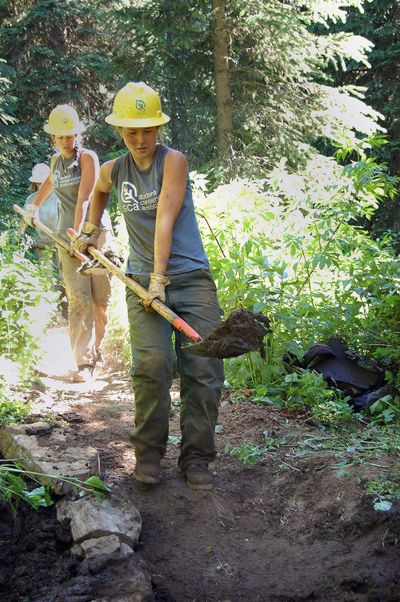Trail work lets kids unplug from world
Urban students working in Idaho forest

GOOSE CREEK, Idaho – While eating lunch under the shade of evergreen trees, a group of eight kids talked about their last meals before heading deep into the wilds of the North Fork of the Clearwater River basin.
Some remembered family meals like burritos. Others recalled airport fare like cheeseburgers or wilted salads. But they all said they eat well in the woods, where everything seems to taste better. It should for this hardworking crew.
The kids came from all across the country to build trails for the Student Conservation Association, a high school version of the Peace Corps. The group connects students with outdoor service projects in an effort to connect them with forests and parks, and instill a lifelong conservation ethic.
It’s tough, grimy duty.
They wielded shovels and Pulaskis, wrestled rocks in and out of the trail, loaded gravel onto mules and spread it on marshy sections of the trail. They placed and removed culverts that funnel creeks under the trail to Goose Lake near the Idaho-Montana state line.
For many, it is their first taste of the remote backcountry. And all said they love it.
“I think the best part is being able to be with a new group of people and getting to know them,” said 17-year-old Saoirse Andrews from Ithaca, N.Y.
Molly Tonsor, a 17-year-old from Pittsburgh, agreed. She said she quickly bonded with the other students. “You have to immediately reach out to people. I had to just jump in and say ‘Hey guys,’ ” she said.
Others were enamored with being disconnected from the wired world they grew up in. There are no cell phones, computers or iPods in this remote corner of Idaho.
Will Ponturo, of Redding, Conn., relished leaving the comforts of home behind for the bare minimums in the wilderness-like setting. “We don’t need to be as reliant on technology as we think we need to be,” he said.
Lia Van Dyke, 15, from Stowe, Vt., agreed. She said at home she often feels obligated to stay connected to all her friends, but she felt free of that in the mountains. “I’m not there so I can’t talk to them,” she said.
But they were tightly connected to each other for the two-week stint of trail labor. They shared meals and elbow grease.
After breakfast each morning, they headed out of camp to chip away at the trail. After a day’s labor, they returned to camp for dinner and time around the campfire.
Rather than plugging in, they had to reach out.
“Instead of listening to music we have to find our own ways to make music,” Andrews said.
They also plugged in, at least mentally, to nature. They saw several deer and found moose and wolf tracks near their camp.
This work party was sponsored by the Clearwater National Forest and groups like the Wilderness Society and the Great Burn Study Group. The Forest Service was able to get some much-needed trail work done and the groups got to expose kids to one place they would like to see preserved.